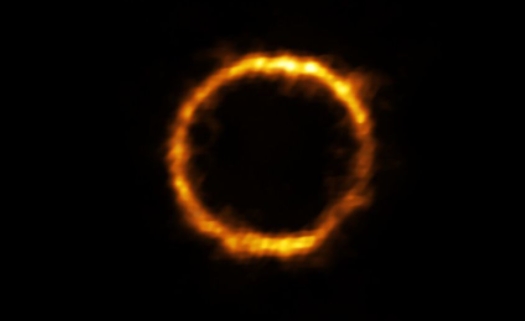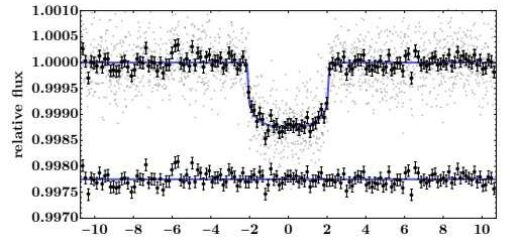Shockingly young galaxy surprises scientists with its impressive bulge

Peering into the early universe, astronomers uncovered a surprise: a young galaxy that looks a lot like our home, the Milky Way.
The newfound galaxy is called SPT0418-47 and, given its great distance from Earth, astronomers see the galaxy as it was when the universe was just 1.4 billion years old — roughly 12 billion years before today.
The discovery held a big surprise for the researchers. Stars were forming quickly, as expected, since there was abundant gas available when the universe was young. But despite the chaos, SPT0418-47 had a well-defined, rotating disk and galactic “bulge” at the center. That’s a similar structure to the Milky Way’s today; moreover, the observed bulge is the most distant ever found in our universe.
A gravitationally lensed view of a ring-shaped slice of a galaxy called SPT0418-47, as seen by the ALMA array in Chile.
A gravitationally lensed view of a ring-shaped slice of a galaxy called SPT0418-47, as seen by the ALMA array in Chile. (Image credit: ALMA (ESO/NAOJ/NRAO), Rizzo et al.)
Analogies between SPT0418-47 and the Milky Way are not perfect, however. The Milky Way sports a distinctive barred-spiral shape, formed by large “arms” of stars and gas. But SPT0418-47 lacks such arms; moreover, scientists expect it will evolve into another galaxy type entirely, an elliptical galaxy.
Yet the newfound galaxy does give insight into the evolution of these massive star-filled structures over the eons. Based on this new find, it appears there may have been less dramatic galaxy change than previously imagined.
“The structures that we observe in nearby spiral galaxies and in our Milky Way were already in place 12 billion years ago,” lead author Francesca Rizzo, a Ph.D. student from Germany’s Max Planck Institute for Astrophysics in Germany, said in a statement from the European Southern Observatory (ESO).
A reconstruction of the full SPT0418-47 galaxy.
A reconstruction of the full SPT0418-47 galaxy. (Image credit: ALMA (ESO/NAOJ/NRAO), Rizzo et al.)
It was the powerful Atacama Large Millimeter/submillimeter Array (ALMA) that allowed astronomers to spy on SPT0418-47. ALMA consists of 66 antennas scattered across the Chilean desert, working together to create one large telescopic lens. The newfound galaxy was too faint to be observed directly, so ALMA used a technique called “gravitational lensing” to overcome the problem, magnifying SPT0418-47’s light using the gravity of a nearby galaxy.
Gravitational lensing can produce some distortion, but in this case, the alignment between the two galaxies was almost exact, according to the statement. This makes SPT0418-47 appear as a nearly perfect ring in the raw images. Researchers found the true shape and gas motion of the galaxy using a new computer model.
Future telescopes, such as ESO’s Extremely Large Telescope, will peer further into the early universe to better figure out how common SPT0418-47’s shape was among the galactic population of the era.
A study based on the research was published on Wednesday (Aug. 12) in the journal Nature.



 Creators of mankind
Creators of mankind Description of “Tall white aliens”
Description of “Tall white aliens” Where they came from?
Where they came from? About hostile civilizations
About hostile civilizations The war for the Earth
The war for the Earth “Tall white aliens” about eternal life
“Tall white aliens” about eternal life Video: “Nordic aliens”
Video: “Nordic aliens” Aliens
Aliens Alien encounters
Alien encounters The aliens base
The aliens base UFO
UFO Technology UFO
Technology UFO Underground civilization
Underground civilization Ancient alien artifacts
Ancient alien artifacts Military and UFO
Military and UFO Mysteries and hypotheses
Mysteries and hypotheses Scientific facts
Scientific facts


















